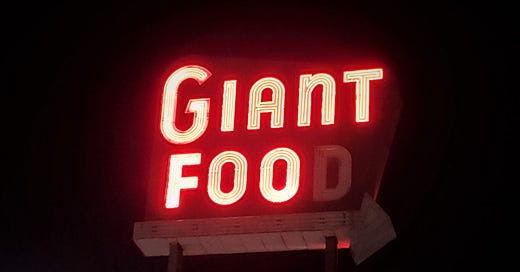I’d like to revisit an article I wrote over a year ago, about neon signs, the Highway Beatification Act, and land use. Read the whole thing—it’s one of my favorite articles, and I still remember the late-night drive I took to Laurel, Maryland to photograph a couple of the signs pictured in there.
In that piece, I argued that the aesthetic and mostly surface-level thrust of the highway beautification movement—anti-neon or blinking-light sign ordinances, billboard removal, plantings along the highway, restrictive zoning for junkyards, etc.—fundamentally got America’s “highway problem” wrong.
Don’t get me wrong, I’m not saying that ugly, cluttered highways are or were a good thing. There really were some serious aesthetic problems back then, some of which rose to the level of being real environmental problems. For example, junked cars were apparently a fairly common sight, and a lot of first-generation roadside development was decaying even by the 1960s. Of course, that decade saw some of the first mainstream books decrying pollution, consumerism, postwar land use, and other social problems. The state of America’s highways was vaguely connected to these problems in a lot of people’s minds.
Including in the mind of Lady Bird Johnson, dubbed by one critical article “Neon Killer.” The First Lady didn’t like neon, and while the Highway Beautification Act didn’t ban it, the movement, and many local ordinances, tried to stamp it out as gaudy and ugly.
In Chester H. Liebs’s excellent book Main Street to Miracle Mile, there’s a quote from Lady Bird herself, who called at a conference in 1965 for “pleasing vistas and attractive roadside scenes” rather than “endless corridors walled in by neon, junk, and ruined landscape.”
As noted, the same ire descended on signs that flashed or blinked. I really wish this fantastic sign, described in a 1979 Washington Post article about Maryland’s Rockville Pike:
[I]n 1970, flashing lights were banned along the Pike. David Gold, manager of George’s, an appliance and furniture store in the Dart Drug shopping center, rues the day they had to turn off George’s sign, whose thousands of light bulbs and sweeping script epitomized the shopping center baroque of its time.
“That sign used to flicker until they made us turn it off,” said Gold, his hands energized by the memory, moving this way and that to depict the sight. “Oh, you should have seen it. It would go black, then red, then yellow. The G would light up, then the E, and the O. Then the rest of the word. Oh, it was so colorful. It was like New York City, only better. We spent a fortune on that sign.”
If only that were in a museum, or even just a warehouse, somewhere. Maybe it is.
The issue is that all of this failed to fix the root problem, which was the spread-out, car-oriented nature of postwar development itself. Making that dysfunctional pattern a little more aesthetically pleasing really didn’t amount to much. There’s only so much that can be done to make this pattern beautiful, and really, it’s not very much.
It’s interesting to think that there was a time when neon was completely unremarkable. And it’s possible to imagine how too much of it could be visually distracting, and, in some placements, could cause noise or light pollution. (I can’t remember where I read it, but I read someone’s account of staying in an old motel, and how the neon sign was so bright that even in the dead of night, his room was still lit up, through the curtains.)
It’s also interesting to me how this ubiquitous signage is now valued as an art form. That transformation in value and perception is fascinating. In a way, what are most antiques or collectibles but everyday artifacts from the past? How much of the curiosity around neon today is a function of its relative rarity, rather than anything inherent in the form itself? I saw this tweet the other day, which actually inspired me to write this post:


Today, the neon problem is that there are too few neon artists left, and it’s proving difficult and expensive to maintain and restore surviving signs, which are now desirable. Roanoke, Virginia, a city with a lot of historic neon signage, has run into this problem. You see this so often: something was once common, then marginalized, then rediscovered and mourned. The same thing, in the same era, happened with “urban renewal.” Old Town Alexandria, one of America’s most loved and most expensive neighborhoods, barely survived the slum-clearance wrecking ball.
page 65 miracle mile lady bird herself on neon
Related Reading:
Please consider upgrading to a paid subscription to help support this newsletter. You’ll get a weekend subscribers-only post, plus full access to the archive of nearly 300 posts and growing. And you’ll help ensure more material like this!




You might want to plan a future road trip to Cincinnati. Besides great beer and food, it's the home of the American Sign Museum: https://www.americansignmuseum.org/.
Yes! I've been meaning to write about the American Sign Museum in Cincinnati. Totally worth a visit if you're ever in the area. https://www.americansignmuseum.org/